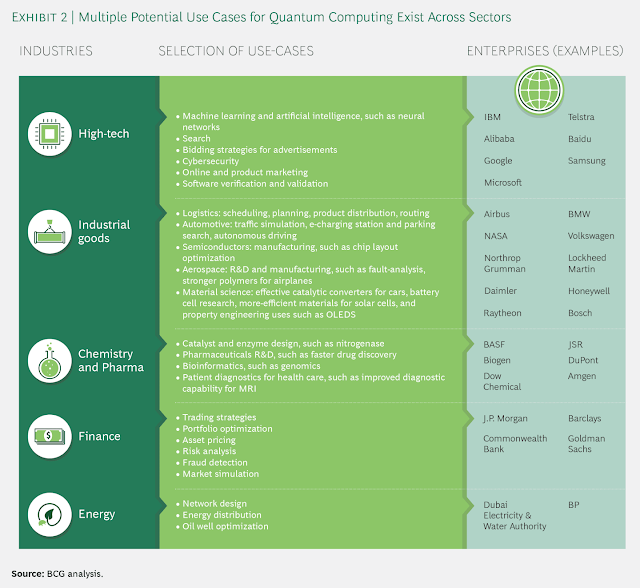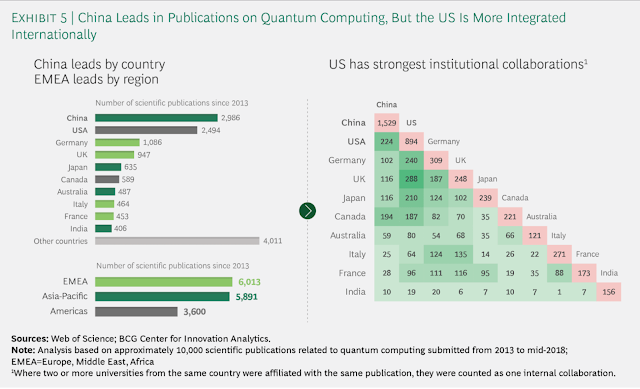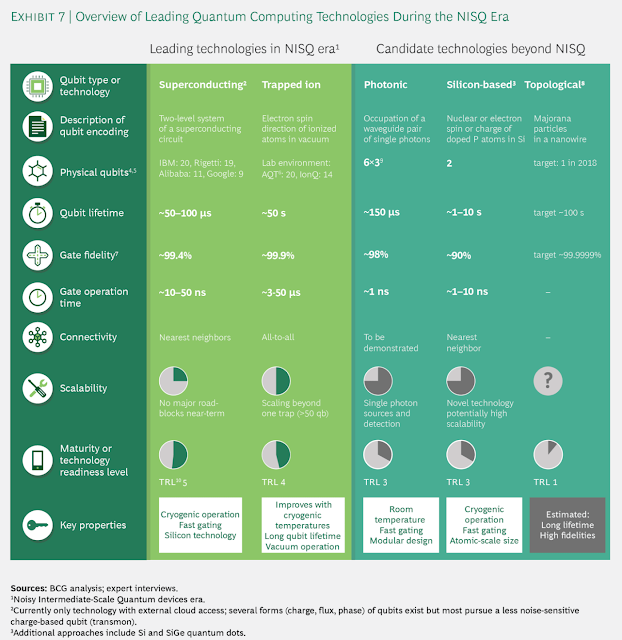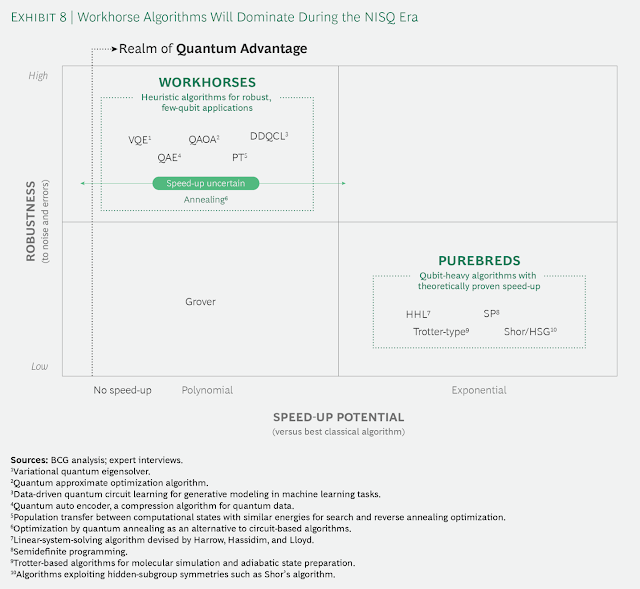The Next Decade in Quantum Computing
The experts are convinced that in time they can build a high-performance quantum computer. Given the technical hurdles that quantum computing faces—manipulations at nanoscale, for instance, or operating either in a vacuum environment or at cryogenic temperatures—the progress in recent years is hard to overstate. In the long term, such machines will very likely shape new computing and business paradigms by solving computational problems that are currently out of reach. They could change the game in such fields as cryptography and chemistry (and thus material science, agriculture, and pharmaceuticals) not to mention artificial intelligence (AI) and machine learning (ML). We can expect additional applications in logistics, manufacturing, finance, and energy. Quantum computing has the potential to revolutionize information processing the way quantum science revolutionized physics a century ago.
Quantum Computing
Every company needs to understand how quantum computing discoveries will affect business.
The future of quantum computing
Toward a Quantum Revolution for Computing
This report explores essential questions for executives and people with a thirst to be up-to-speed on quantum computing. We will look at where the technology itself currently stands, who is who in the emerging ecosystem, and the potentially interesting applications. We will analyze the leading indicators of investments, patents, and publications; which countries and entities are most active; and the status and prospects for the principal quantum hardware technologies. We will also provide a simple framework for understanding algorithms and assessing their applicability and potential. Finally, our short tour will paint a picture of what can be expected in the next five to ten years, and what companies should be doing—or getting ready for—in response.
How Quantum Computers Are Different, and Why It Matters
The first classical computers were actually analog machines, but these proved to be too error-prone to compete with their digital cousins. Later generations used discrete digital bits, taking the values of zero and one, and some basic gates to perform logical operations. As Moore’s law describes, digital computers got faster, smaller, and more powerful at an accelerating pace. Today a typical computer chip holds about 20x109 bits (or transistors) while the latest smartphone chip holds about 6x109 bits. Digital computers are known to be universal in the sense that they can in principle solve any computational problem (although they possibly require an impractically long time). Digital computers are also truly reliable at the bit level, with fewer than one error in 1024 operations; the far more common sources of error are software and mechanical malfunction.Qubits can enable quantum computing to achieve an exponentially higher information density than classical computers.
Quantum computing random walks and adiabatic computation
Quantum computers, building on the pioneering ideas of physicists Richard Feynman and David Deutsch in the 1980s, leverage the unique properties of matter at nanoscale. They differ from classical computers in two fundamental ways. First, quantum computing is not built on bits that are either zero or one, but on qubits that can be overlays of zeros and ones (meaning part zero and part one at the same time). Second, qubits do not exist in isolation but instead become entangled and act as a group. These two properties enable qubits to achieve an exponentially higher information density than classical computers.
There is a catch, however: qubits are highly susceptible to disturbances by their environment, which makes both qubits and qubit operations (the so-called quantum gates) extremely prone to error. Correcting these errors is possible but it can require a huge overhead of auxiliary calculations, causing quantum computers to be very difficult to scale. In addition, when providing an output, quantum states lose all their richness and can only produce a restricted set of probabilistic answers. Narrowing these probabilities to the “right” answer has its own challenges, and building algorithms in a way that renders these answers useful is an entire engineering field in itself.
Future Decoded Quantum Computing Keynote
That said, scientists are now confident that quantum computers will not suffer the fate of analog computers—that is, being killed off by the challenges of error correction. But the requisite overhead, possibly on the order of 1,000 error-correcting qubits for each calculating qubit, does mean that the next five to ten years of development will probably take place without error correction (unless a major breakthrough on high-quality qubits surfaces). This era, when theory continues to advance and is joined by experiments based on these so-called NISQ (Noisy Intermediate-Scale Quantum) devices, is the focus of this report. (For more on the particular properties of quantum computers, see the sidebar, “The Critical Properties of Quantum Computers.” For a longer-term view of the market potential for, and development of, quantum computers, see “The Coming Quantum Leap in Computing,” BCG article, May 2018. For additional context—and some fun—take the BCG Quantum Computing Test.)
The Emerging Quantum Computing Ecosystem
Quantum computing technology is well-enough developed, and practical uses are in sufficiently close sight, for an ecosystem of hardware and software architects and developers, contributors, investors, potential users, and collateral players to take shape. Here’s a look at the principal participants.TECH COMPANIES
Universities and research institutions, often funded by governments, have been active in quantum computing for decades. More recently, as has occurred with other technologies (big data for example), an increasingly well-defined technology stack is emerging, throughout which a variety of private tech players have positioned themselves.
Efficient Synthesis of Universal Probabilistic Quantum Circuits
An increasingly well-defined technology stack is emerging.
At the base of the stack is quantum hardware, where the arrays of qubits that perform the calculations are built. The next layer is sophisticated control systems, whose core role is to regulate the status of the entire apparatus and to enable the calculations. Control systems are responsible in particular for gate operations, classical and quantum computing integration, and error correction. These two layers continue to be the most technologically challenging.Next comes a software layer to implement algorithms (and in the future, error codes) and to execute applications. This layer includes a quantum-classical interface that compiles source code into executable programs. At the top of the stack are a wider variety of services dedicated to enabling companies to use quantum computing. In particular they help assess and translate real-life problems into a problem format that quantum computers can address.
The actual players fall into four broad categories.
End-to-End Providers. These tend to be big tech companies and well-funded startups. Among the former, IBM has been the pioneer in quantum computing and continues at the forefront of the field. The company has now been joined by several other leading-edge organizations that play across the entire stack. Google and more recently Alibaba have drawn a lot of attention. Microsoft is active but has yet to unveil achievements toward actual hardware. Honeywell has just emerged as a new player, adding to the heft of the group. Rigetti is the most advanced among the startups. (See “Chad Rigetti on the Race for Quantum Advantage: An Interview with the Founder and CEO of Rigetti Computing,” BCG interview, November 2018.)
Each company offers its own cloud-based open-source software platform and varying levels of access to hardware, simulators, and partnerships. In 2016 IBM launched Q Experience, arguably still the most extensive platform to date, followed in 2018 by Rigetti’s Forest, Google’s Cirq, and Alibaba’s Aliyun, which has launched a quantum cloud computing service in cooperation with the Chinese Academy of Sciences. Microsoft provides access to a quantum simulator on Azure using its Quantum Development Kit. Finally, D-Wave Systems, the first company ever to sell quantum computers (albeit for a special purpose), launched Leap, its own real-time cloud access to its quantum annealer hardware, in October 2018.
Particle Physics On a Chip the Search for Majorana Fermions - Leo Kouwenhoven
Hardware and Systems Players. Other entities are focused on developing hardware only, since this is the core bottleneck today. Again, these include both technology giants, such as Intel, and startups, such as IonQ, Quantum Circuits, and QuTech. Quantum Circuits, a spinoff from Yale University, intends to build a robust quantum computer based on a unique, modular architecture, while QuTech—a joint effort between Delft University of Technology and TNO, the applied scientific research organization, in the Netherlands—offers a variety of partnering options for companies. An example of hardware and systems players extending into software and services, QuTech launched Quantum Inspire, the first European quantum computing platform, with supercomputing access to a quantum simulator. Quantum hardware access is planned to be available in the first half of 2019.
Software and Services Players. Another group of companies is working on enabling applications and translating real-world problems into the quantum world. They include Zapata Computing, QC Ware, QxBranch, and Cambridge Quantum Computing, among others, which provide software and services to users. Such companies see themselves as an important interface between emerging users of quantum computing and the hardware stack. All are partners of one or more of the end-to-end or hardware players within their mini-ecosystems. They have, however, widely varying commitments and approaches to advancing original quantum algorithms.
Specialists. These are mainly startups, often spun off from research institutions, that provide focused solutions to other quantum computing players or to enterprise users. For example, Q-CTRL works on solutions to provide better system control and gate operations, and Quantum Benchmark assesses and predicts errors of hardware and specific algorithms. Both serve hardware companies and users.
The ecosystem is dynamic and the lines between tech layers easily blurred or crossed.
Particle Physics On a Chip the Search for Majorana Fermions
The ecosystem is dynamic and the lines between layers easily blurred or crossed, in particular by maturing hardware players extending into the higher-level application, or even service layers. The end-to-end integrated companies continue to reside at the center of the technology ecosystem for now; vertical integration provides a performance advantage at the current maturity level of the industry. The biggest investments thus far have flowed into the stack’s lower layers, but we have not yet seen a convergence on a single winning architecture. Several architectures may coexist over a longer period and even work hand-in-hand in a hybrid fashion to leverage the advantages of each technology.
APPLICATIONS AND USERS
For many years, the biggest potential end users for quantum computing capability were national governments. One of the earliest algorithms to demonstrate potential quantum advantage was developed in 1994 by mathematician Peter Shor, now at the Massachusetts Institute of Technology. Shor’s algorithm has famously demonstrated how a quantum computer could crack current cryptography. Such a breach could endanger communications security, possibly undermining the internet and national defense systems, among other things. Significant government funds flowed fast into quantum computing research thereafter. Widespread consensus eventually formed that algorithms such as Shor’s would remain beyond the realm of quantum computers for some years to come and even if current cryptographic methods are threatened, other solutions exist and are being assessed by standard-setting institutions. This has allowed the private sector to develop and pursue other applications of quantum computing. (The covert activity of governments continues in the field, but is outside the scope of this report.)Quantum Algorithm - The Math of Intelligence
Quite a few industries outside the tech sector have taken notice of the developments in, and the potential of, quantum computing, and companies are joining forces with tech players to explore potential uses. The most common categories of use are for simulation, optimization, machine learning, and AI. Not surprisingly, there are plenty of potential applications.
Despite many announcements, though, we have yet to see an application where quantum advantage—that is, performance by a quantum computer that is superior in terms of time, cost, or quality—has been achieved.
However, such a demonstration is deemed imminent, and Rigetti recently offered a $1 million prize to the first group that proves quantum advantage.
Investments, Publications, and Intellectual Property
The activity around quantum computing has sparked a high degree of interest.2 People have plenty of questions. How much money is behind quantum computing? Who is providing it? Where does the technology stand compared with AI or blockchain? What regions and entities are leading in publications and IP?With more than 60 separate investments totaling more than $700 million since 2012, quantum computing has come to the attention of venture investors, even if is still dwarfed by more mature and market-ready technologies such as blockchain (1,500 deals, $12 billion, not including cryptocurrencies) and AI (9,800 deals, $110 billion).
The bulk of the private quantum computing deals over the last several years took place in the US, Canada, the UK, and Australia. Among startups, D-Wave ($205 million, started before 2012), Rigetti ($119 million), PsiQ ($65 million), Silicon Quantum Computing ($60 million), Cambridge Quantum Computing ($50 million), 1Qbit ($35 million), IonQ ($22 million), and Quantum Circuits ($18 million) have led the way.
A regional race is also developing, involving large publicly funded programs that are devoted to quantum technologies more broadly, including quantum communication and sensing as well as computing. China leads the pack with a $10 billion quantum program spanning the next five years, of which $3 billion is reserved for quantum computing. Europe is in the game ($1.1 billion of funding from the European Commission and European member states), as are individual countries in the region, most prominently the UK ($381 million in the UK National Quantum Technologies Programme). The US House of Representatives passed the National Quantum Initiative Act ($1.275 billion, complementing ongoing Department of Energy, Army Research Office, and National Science Foundation initiatives). Many other countries, notably Australia, Canada, and Israel are also very active.
The money has been accompanied by a flurry of patents and publishing. (See Exhibit 4.) North America and East Asia are clearly in the lead; these are also the regions with the most active commercial technology activity. Europe is a distant third, an alarming sign, especially in light of a number of leading European quantum experts joining US-based companies in recent years. Australia, a hotspot for quantum technologies for many years, is striking given its much smaller population. The country is determined to play in the quantum race; in fact, one of its leading quantum computing researchers, Michelle Simmons, was named Australian of the Year 2018.
Two things are noteworthy about the volume of scientific publishing regarding quantum computing since 2013. (See Exhibit 5.) The first is the rise of China, which has surpassed the US to become the leader in quantity of scientific articles published.3 The second is the high degree of international collaboration (in which the US remains the primary hub). The cooperation shows that quantum computing is not dominated by national security interests yet, owing in large part to consensus around the view that cryptographic applications are still further in the future and that effective remedies for such applications are in the making. The collaboration activity also reflects the need in the scientific community for active exchange of information and ideas to overcome quantum computing’s technological and engineering challenges.
Simplifying the Quantum Algorithm Zoo
The US National Institute for Standards and Technology (NIST) maintains a webpage entitled Quantum Algorithm Zoo that contains descriptions of more than 60 types of quantum algorithms. It’s an admirable effort to catalog the current state of the art, but it will make nonexperts’ heads spin, as well as those of some experts.Quantum algorithms are the tools that tell quantum computers what to do. Two of their attributes are especially important in the near term:
Speed-Up. How much faster can a quantum computer running the algorithm solve a particular class of problem than the best-known classical computing counterpart?
Robustness. How resilient is the algorithm to the random “noise,” or other errors, in quantum computing?
There are two classes of algorithm today. (See Exhibit 8.) We call the first purebreds—they are built for speed in noiseless or error-corrected environments. The ones shown in the exhibit have theoretically proven exponential speed-up over conventional computers for specific problems, but require a long sequence of flawless execution, which in turn necessitate very low noise operations and error correction. This class includes Peter Shor’s factorization algorithm for cracking cryptography and Trotter-type algorithms used for molecular simulation. Unfortunately, their susceptibility to noise puts them out of the realm of practical application for the next ten years and perhaps longer.
Why the Deutsch-Josza Algorithm?
Deutsch–Jozsa algorithm. ... Although of little practical use, it is one of the first examples of a quantum algorithm that is exponentially faster than any possible deterministic classical algorithm. It is also a deterministic algorithm, meaning that it always produces an answer, and that answer is always correct.Deutsch-Jozsa Algorithm
The Deutsch-Jozsa algorithm was the first to show a separation between the quantum and classical difficulty of a problem. This algorithm demonstrates the significance of allowing quantum amplitudes to take both positive and negative values, as opposed to classical probabilities that are always non-negative.
The Deutsch-Jozsa problem is defined as follows. Consider a function f(x)
that takes as input n
-bit strings x
and returns 0
or 1
. Suppose we are promised that f(x)
is either a constant function that takes the same value c∈{0,1}
on all inputs x
, or a balanced function that takes each value 0
and 1
on exactly half of the inputs. The goal is to decide whether f
is constant or balanced by making as few function evaluations as possible. Classically, it requires 2n−1+1
function evaluations in the worst case. Using the Deutsch-Jozsa algorithm, the question can be answered with just one function evaluation. In the quantum world the function f
is specified by an oracle circuit Uf
(see the previous section on Grover’s algorithm, such that Uf|x⟩=(−1)f(x)|x⟩
).
Quantum Circuits and Algorithms
To understand how the Deutsch-Jozsa algorithm works, let us first consider a typical interference experiment: a particle that behaves like a wave, such as a photon, can travel from the source to an array of detectors by following two or more paths simultaneously. The probability of observing the particle will be concentrated at those detectors where most of the incoming waves arrive with the same phase.
Imagine that we can set up an interference experiment as above, with 2n
detectors and 2n
possible paths from the source to each of the detectors. We shall label the paths and the detectors with n
-bit strings x
and y
respectively. Suppose further that the phase accumulated along a path x
to a detector y
equals C(−1)f(x)+x⋅y
, where
x⋅y=∑ni=1xiyi
is the binary inner product and C
is a normalizing coefficient. The probability to observe the particle at a detector y
can be computed by summing up amplitudes of all paths x
arriving at y
and taking the absolute value squared:
Pr(y)=|C∑x(−1)f(x)+x⋅y|2
Normalization condition ∑yPr(y)=1
then gives C=2−n
. Let us compute the probability Pr(y=0n)
of observing the particle at the detector y=0n
(all zeros string). We have Pr(y=0n)=|2−n∑x(−1)f(x)|2
If f(x)=c
is a constant function, we get Pr(y=0n)=|(−1)c|2=1
. However, if f(x)
is a balanced function, we get Pr(y=0n)=0
, since all the terms in the sum over x
cancel each other.
We can therefore determine whether f
is constant or balanced with certainty by running the experiment just once.
Of course, this experiment is not practical since it would require an impossibly large optical table! However, we can simulate this experiment on a quantum computer with just n
qubits and access to the oracle circuit Uf
. Indeed, consider the following algorithm:
Step 1. Initialize n
qubits in the all-zeros state |0,…,0⟩
.
Step 2. Apply the Hadamard gate H
to each qubit.
Step 3. Apply the oracle circuit Uf
.
Step 4. Repeat Step 2.
Step 5. Measure each qubit. Let y=(y1,…,yn)
be the list of measurement outcomes.
We find that f
is a constant function if y
is the all-zeros string. Why does this work? Recall that the Hadamard gate H
maps |0⟩
to the uniform superposition of |0⟩
and |1⟩
. Thus the state reached after Step 2 is 2−n/2∑x|x⟩
, where the sum runs over all n
-bit strings. The oracle circuit maps this state to 2−n/2∑x(−1)f(x)|x⟩
. Finally, let us apply the layer of Hadamards at Step 4. It maps a basis state |x⟩
to a superposition 2−n/2∑y(−1)x⋅y|y⟩
. Thus the state reached after Step 4 is |ψ⟩=∑yψ(y)|y⟩
, where ψ(y)=2−n∑x(−1)f(x)+x⋅y
.
Using QISkit: The SDK for Quantum Computing
at Step 5 is one if f
is a constant function and zero if f
is a balanced function. Thus we have solved the Deutsch-Jozsa problem with certainty by making just one function evaluation.
Example circuits
Suppose n=3
and f(x)=x0⊕x1x2
. This function is balanced since flipping the bit x0
flips the value of f(x)
regardless of x1,x2
. To run the Deutsch-Jozsa algorithm we need an explicit description of the oracle circuit Uf
as a sequence of quantum gates. To this end we need a Z0
gate such that Z0|x⟩=(−1)x0|x⟩
and a controlled-Z gate CZ1,2
such that CZ1,2|x⟩=(−1)x1x2|x⟩
. Using basic circuit identities (see the Basic Circuit Identities and Larger Circuits section), one can realize the controlled-Z gate as a CNOT sandwiched between two Hadamard gates.
Quantum information and computation: Why, what, and how
A Potential Quantum Winter, and the Opportunity Therein
Like many theoretical technologies that promise ultimate practical application someday, quantum computing has already been through cycles of excitement and disappointment. The run of progress over past years is tangible, however, and has led to an increasingly high level of interest and investment activity. But the ultimate pace and roadmap are still uncertain because significant hurdles remain. While the NISQ period undoubtedly has a few surprises and breakthroughs in store, the pathway toward a fault-tolerant quantum computer may well turn out to be the key to unearthing the full potential of quantum computing applications.
Some experts thus warn of a potential “quantum winter,” in which some exaggerated excitement cools and the buzz moves to other things. Even if such a chill settles in, for those with a strong vison of their future in both the medium and longer terms, it may pay to remember the banker Baron Rothschild’s admonition during the panic after the Battle of Waterloo: “The time to buy is when there’s blood in the streets.” During periods of disillusionment, companies build the basis of true competitive advantage. Whoever stakes out the most important business beachheads in the emerging quantum computing technologies will very likely do so over the next few years. The question is not whether or when, but how, companies should get involved.
More Information
http://www.infocobuild.com/education/audio-video-courses/physics/QuantumInformationComputing-IIT-Bombay/lecture-17.htmlhttps://www.microsoft.com/en-us/research/group/microsoft-quantum-redmond-quarc/
https://www.microsoft.com/en-us/research/group/microsoft-quantum-santa-barbara-station-q/
http://kouwenhovenlab.tudelft.nl/
https://qdev.nbi.ku.dk/
https://equs.org/users/prof-david-reilly
https://www.microsoft.com/en-us/research/research-area/quantum/
https://www.microsoft.com/en-us/research/blog/future-is-quantum-with-dr-krysta-svore/
https://www.microsoft.com/en-us/quantum/development-kit
https://www.tudelft.nl/en/2017/tnw/majorana-highway-on-a-chip/
https://phys.org/news/2017-07-majorana-highway-chip.html
https://www.microsoft.com/en-us/research/blog/future-is-quantum-with-dr-krysta-svore/
https://quantumexperience.ng.bluemix.net/proxy/tutorial/full-user-guide/004-Quantum_Algorithms/080-Deutsch-Jozsa_Algorithm.html
http://demonstrations.wolfram.com/DeutschsAlgorithmOnAQuantumComputer/
https://singularityhub.com/2019/02/26/quantum-computing-now-and-in-the-not-too-distant-future/
https://www.scientificamerican.com/article/is-the-u-s-lagging-in-the-quest-for-quantum-computing/?redirect=1
https://www.quantamagazine.org/tag/the-future-of-quantum-computing/
https://www.quantamagazine.org/quantum-computers-struggle-against-classical-algorithms-20180201/
https://www.ncbi.nlm.nih.gov/pmc/articles/PMC6205278/
https://www.bcg.com/en-us/publications/2018/next-decade-quantum-computing-how-play.aspx
https://en.wikipedia.org/wiki/Deutsch–Jozsa_algorithm






